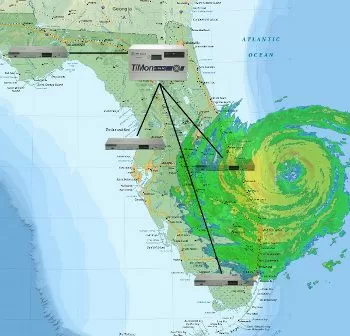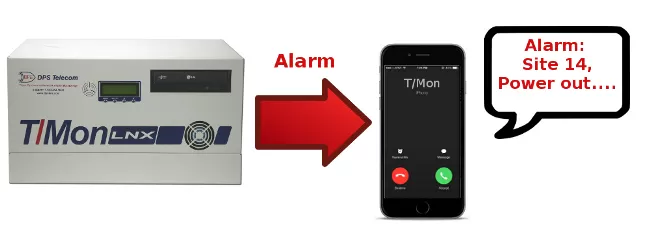Check out our White Paper Series!
A complete library of helpful advice and survival guides for every aspect of system monitoring and control.
1-800-693-0351
Have a specific question? Ask our team of expert engineers and get a specific answer!
Sign up for the next DPS Factory Training!

Whether you're new to our equipment or you've used it for years, DPS factory training is the best way to get more from your monitoring.
Reserve Your Seat TodayThe weather can be cruel and unpredictable. Every so often, a catastrophic meteorological event brings destruction in a part of the world.
In our modern world, many lives depend on telecom networks. First response services must be available, commercial power has to stay online, transit systems need to keep moving. Storms become increasingly lethal if infrastructures aren't resilient.
Sometimes, networks will fail and power will go out. After providing multiple remote monitoring solutions for these kinds of scenarios, we know though that a properly monitored network can reduce return-to-service times and restore critical functions for those who need it most after a powerful storm.

While much of your daily functions are based on networks and commercial power, they become even more crucial in the eye of the storm. It's critical that you know ways to keep them online or at least reduce the time they're offline.
Learn how you can weather-proof your telecom network.
While the hope is nobody has the misfortune to find themselves in weather's destructive path (or, if they do, that they remain safe), we must prepare for the very real possibility of bad weather and network downtime.
Here are 16 best practices to put in practice to safeguard your network.
This point is especially important if you need to access the safety of a remote facility before dispatching a crew.
Companies, for example, use an ultrasonic snow depth sensor with an RTU at one of its sites located on a mountaintop. The sensor enables them to see if the snow is becoming dangerously deep, allowing them to dispatch techs via snowmobile or even helicopter to clear out the compound while it's still safe.
Set analog thresholds and traps to alert you before environmental readings at your site reach critical, equipment-damaging levels. This will alert you to problems at your sites, but still give you time to respond accordingly, before your equipment (or your network) fails.
Since SNMP traps are so important to network monitoring, look for RTUs that have the capability to send traps at regular intervals that contain values, rather than standard threshold traps. This allows users to track trends and see if an environmental value is rapidly approaching one of the thresholds.
The ability to remote control your equipment is of extreme importance. If you can simply press a button or flip a switch remotely, you'll avoid sending techs to dangerous areas while still protecting your network.
For example, if you have wind turbines, you could easily install breaks on the turbines, so you can stop them remotely in the event of heavy winds.
Derived controls provide an always-on, instantaneous first line of defense against equipment problems that can cause network downtime. An RTU that supports derived controls will automatically operate control relays in response to alarm inputs.
If you derive a control from an analog wind sensor, for example, the derived control can lower your site's antenna before the wind becomes dangerous enough to damage it.
Have remote monitoring devices that allow you to configure notifications, as well as user profiles and schedules. This way you make sure that the right person knows about the right problem at the right time.
Don't filter your alarms manually. With qualification timers, you can configure alarms to set only after alarm conditions have been present for long enough to require your attention.
Remotely operate backup HVAC at your site, so your equipment doesn't fry in a heat wave or freeze up in harsh winter.
Some of the better remotes available right now can be ordered with a terminal server, allowing you to use and control your serial equipment remotely. This way you can fix problems without having to travel to your remote site.
Make sure your network is always properly monitored by keeping a second network master in an alternate location. This practice reduces the likelihood of a catastrophic failure that could leave your network and your techs in the dark.
Having an RTU that you can connect with via LAN, wirelessly, or over POTS, helps ensure that you'll be able to keep your remote sites visible despite the worst storms.
If you lose LAN connection, for example, your RTU would still be able to transmit data via dial-up connection.
Using analog sensors to check your fuel and battery levels will help you stay prepared, so even if the commercial power goes offline, your site won't. You can even use a remote power switch so you can reboot your units and control power remotely while still maintaining RTU functionality.
Turn off your equipment in the event of dangerous weather - a flood - or simply reboot it so you don't have to roll a truck in the middle of a hurricane.
Some of the more sophisticated RTUs and masters can send emails notifying you and your techs of network problems.

Advanced alarm masters can send emails with an acknowledgeable link in the email. This way your technicians can "ack" the alarm and fully automate the alarm-dispatching system. Some alarm remotes can send SMS or voice messages, and allow you to set an order in which your techs are to be contacted.
With good monitoring equipment, you have a number of options to remain aware of your sites before, during, and after the storm without being anywhere near your sites.
By seeing what sites are suffering, you can more-easily visualize where your network's problems are and prioritize your responses.
If a switch site sits between a master and three sites that are down, you can plainly see where the problem is and dispatch the right person, to the right location even if you don't necessarily see an alarm at the switch.
When the storm hits, you need to be ready. Have a plan to handle catastrophic events, a procedure to follow, so there's never any question of who should do what, and the systems necessary to provide actionable information so you can implement the plan and follow the procedure.
Being ready for hard weather isn't just about the equipment. If you don't have a recovery plan and procedures in place to make sure the plan is acted on, the information provided by the systems is far less useful to you, your network, your clients, and the safety of everyone involved.
All equipment will fail eventually, but it's far more likely to kick-the-bucket in a fit of poor weather. If you're stocked with spare equipment, especially if you have database and other configuration information backed up, you'll have a much easier time getting your network back up online quickly.
Modern masters allow users to filter alarms to get at the root of a problem when a large number of points fail.
For example, if a DS3 or Fiber fails, the T1 alarms it sets are irrelevant. The root alarm feature allows you to set an alarm as a root, and, should it fail, it will automatically silence the alarms associated with it, so that you can see the problem more clearly.
Part of preparing your network to survive harsh weather is having a disaster recovery plan, so when the worst happens, you can get your network back online in an organized, timely way.
To that end, here are 6 points you should consider when creating a plan to get your network back online.
An analysis of disasters that could occur in your region
What kinds of natural disasters can strike your remote sites? Hurricanes? Maybe earthquakes? Maybe even tornadoes?
A prioritized list of the network systems that will be affected by a possible disaster
Knowing what could go wrong and working out a priority list for fixing downed equipment will help you send technicians to the right sites with the right tools in the right order when disaster actually strikes.
Established procedures for repairing critical systems under disaster conditions
Are your spares already databased with the appropriate information? Do you need to set jumpers on your analogs to measure current? Make sure you have a documented plan for setting up equipment quickly, and make sure that it's accessible (via IP preferably), so if something goes wrong, your people will know just what to do to get it fixed.
An inventory of critical spare equipment and parts
When you keep an inventory of vital spare equipment and parts, you don't have to wait for a shipment to set your network straight. If your network covers a large area, consider employing local part depots, so your spares can get from storage to site quickly.
Have an alternate data path for transporting alarms and information in case of the primary path fails
In too many networks, the only data path for transporting network monitoring information is the network being monitored. When that network fails, you're stuck without the information you need to intelligently dispatch your technicians to get it fixed. An alternate data path ensures you can still get the information you need to fix your troubled network.
Have a people plan
Keep a series of critical employees and vendor numbers handy. This way, if your network suffers an outage, you waste no time getting a hold of the people you need to help you get it back online.
Once you have a plan, don't let it sit in the back of a filing cabinet. Drill your staff on disaster recovery procedures and make sure they know how to find their disaster recovery plan, so when the worst happens, you can react accordingly.
The bottom line is that unpredictable weather and natural disasters can do a number on your network. So, when Mother Nature throws her worst at you, you need to be prepared to keep your network online, or, if it fails, to get it back online quickly.
However, before you start working on your disaster recovery plans, there's still a lot more you need to know.
To help you get the information you need, we offer free, live web demonstrations of SNMP monitoring solutions with the T/Mon Alarm Master. Of course, there's no obligation to buy, our intent is only to provide straightforward information to help you make the best decision about your network monitoring.
So, to know how you can improve your remote site maintenance, simply contact us and schedule your free web demo.

Morgana Siggins
Morgana Siggins is a marketing writer, content creator, and documentation specialist at DPS Telecom. She has created over 200 blog articles and videos sharing her years of experience in the remote monitoring industry.